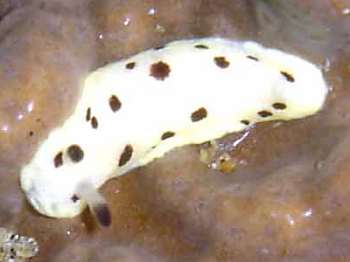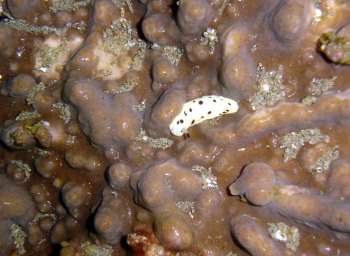
Aphelodoris sp. 4
Order: NUDIBRANCHIA
Suborder: DORIDINA
Superfamily: EUDORIDOIDEA
Family: Dorididae
DISTRIBUTION
Probably endemic to South African
PHOTO
Sodwana, South Africa. Indian Ocean. Depth: 18 metres. Length: 20 mm. Dec 2004. Coral reef. Photographer: Colin Ogden
I am pretty sure this is a species of Aphelodoris, which Gosliner (1987: species 83, p.67) illustrates. He considers it to be endemic to southern Africa. As far as I know it has't as yet been named. I have included a shot alongside showing the sponge it was on. Further sightings on the same sponge may be useful in deciding whether it's there by chance, or whether it feeds on this sponge.
-
Gosliner, T. M. (1987) Nudibranchs of Southern Africa, a guide to the Opisthobranchs of southern Africa. Monterey, Sea Challengers. 1-136.
Rudman, W.B., 2005 (May 25) Aphelodoris sp. 4 [In] Sea Slug Forum. Australian Museum, Sydney. Available from http://www.seaslugforum.net/find/aphesp4
Related messages
Aphelodoris from South Africa
June 1, 2005
From: Colin Ogden
Hi Bill,
Thanks for your info on the Aphelodoris [message #13876 ].
I have referred to Gosliner's book, and he says that the specimen he has was collected at Llandudno, and Danger Point which are both Atlantic and very cold water about 9 degrees cel, compared to Sodwana Bay (Indian Ocean)which in summer is about 28 degrees. Is it possible for this nudi to exist in both places?
Thanks
Colin Ogden
scubaco@iafrica.com
Ogden, C.M., 2005 (Jun 1) Aphelodoris from South Africa. [Message in] Sea Slug Forum. Australian Museum, Sydney. Available from http://www.seaslugforum.net/find/13895Thanks Colin,
I followed Terry Gosliner who says Danger Point is in the Indian Ocean but looking at a map I see its probably a matter of definition. Without some information on its anatomy I can't be sure, but it certainly looks like Gosliner's photo of Aphelodoris. Could it occur in both places? I couldn't say, but tropical animals do sometimes survive in much cooler temperate waters, and from my experience living in Tanzania, many tropical species do not last long when the water gets really warm.
I guess this is one of many times when 'I don't know' is the best answer
Best wishes,
Bill Rudman
Aphelodoris from Sodwana Bay, Sth Africa
May 26, 2005
From: Colin Ogden

Hi Bill,
thanks so much for your help so far. I am attaching another nudi I can't ID
Locality: Sodwana, South Africa. Indian Ocean. Depth: 18 metres. Length: 20 mm. Dec 2004. Coral reef. Photographer: Colin Ogden
Thanks,
Colin
scubaco@iafrica.com
Ogden C. M., 2005 (May 26) Aphelodoris from Sodwana Bay, Sth Africa. [Message in] Sea Slug Forum. Australian Museum, Sydney. Available from http://www.seaslugforum.net/find/13876
Dear Colin,
I am pretty sure this is a species of Aphelodoris, which Gosliner (1987: species 83, p.67) illustrates. He considers it to be endemic to southern Africa. As far as I know it has't as yet been named. I have included a shot alongside showing the sponge it was on. Further sightings on the same sponge may be useful in deciding whether it's there by chance, or whether it feeds on this sponge.
-
Gosliner, T. M. (1987) Nudibranchs of Southern Africa, a guide to the Opisthobranchs of southern Africa. Monterey, Sea Challengers. 1-136.
Best wishes,
Bill Rudman
